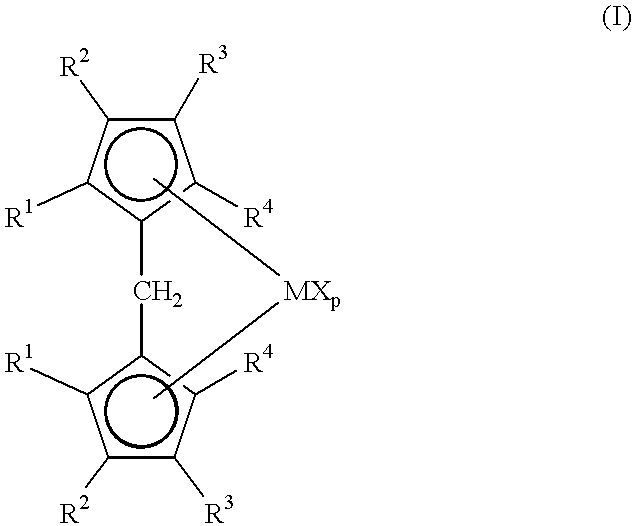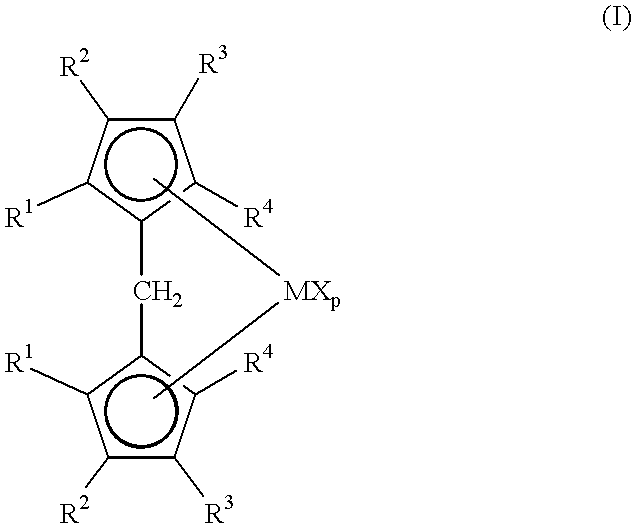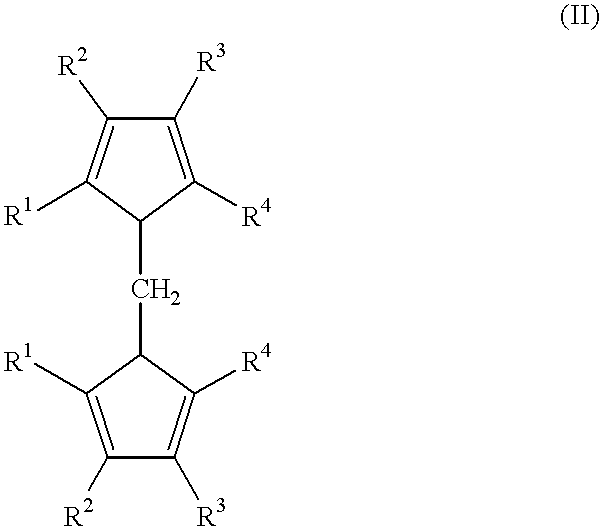Metallocene compounds and their use in catalysts for the polymerization of olefins
a technology of olefin polymerization and metalocene compounds, which is applied in the direction of catalyst activation/preparation, group 5/15 element organic compounds, hydrocarbon preparation catalysts, etc., can solve the problem that the molecular weight that can be obtained at polymerization temperature of industrial interest is still too low for many utilizations
- Summary
- Abstract
- Description
- Claims
- Application Information
AI Technical Summary
Benefits of technology
Problems solved by technology
Method used
Image
Examples
example 7
Ethylene / 1-hexene Copolymerization
Example 1 was repeated with the following differences: instead of the 90 ml of hexane, 80 ml of heptane and 10 ml of 1-hexene were introduced in the autoclave; the catalytic system was prepared in 10 mL of heptane instead of hexane; the polymerization was run at 70.degree. C. and 4.5 barg and it was stopped after 10 minutes. The yield was 1.0 g corresponding to an activity of 339.9 Kg / mmol.sub.zr.h. The intrinsic viscosity of the copolymer was 2.59 dL / g. The amount of 1-hexene units in the copolymer was 13.7% by weight.
example 8
Ethylene / propylene Copolymerization
The copolymerization was carried out by continuously supplying the monomer mixture at a constant flow rate in a 250 mL glass reactor equipped with stirring and a thermometer. The cocatalyst was prepared by dissolving 3.45 mL of TIOA (1 M in hexane) in 5 mL of toluene, then adding 0.031 mL of water and then stirring the solution for 10 minutes. The cocatalyst was then added to the nitrogen purged reactor containing 95 mL of toluene. The reactor was put into a thermostatted bath and, when the reaction temperature of 50.degree. C. was reached, a mixture of ethylene and propylene containing 60% wt of ethylene was supplied continuously, at a total pressure of 80 mmHg and a flow rate of 80 L / h. 1.8 mg (3.45 mmol) of rac-methylene-bis(3-t-butyl-1-indenyl)zirconium dichloride, dissolved in 5 mL of toluene, were added to start the polymerization. After 15 minutes, the polymerization reaction was stopped by adding 1 mL of methanol and the copolymer was coagu...
examples 9-10 , 15-23 and 29-33
EXAMPLES 9-10, 15-23 and 29-33, and COMPARATIVE EXAMPLES 11-14 and 24-28
Propylene Polymerization
200 g of propylene were charged in a 1-L jacketed stainless-steel autoclave, equipped with magnetically driven stirrer and a 35-mL stainless-steel vial, connected to a thermostat for temperature control; the autoclave had been previously purified by washing with a TIBA solution in hexanes, dried at 50.degree. C. in a stream of propylene and finally cooled to room temperature (in examples 16-23 and 29-33, a 4.25-L autoclave was used and propylene was charged therein, in order to have a volume of 2 L of liquid propylene, at the polymerization temperature). When used, hydrogen was charged in the reactor at room temperature, before charging liquid propylene. The autoclave was then thermostatted at the polymerization temperature indicated in Table 2. The catalyst mixture was prepared by adding the amount of the racemic zirconocene dichloride indicated in Table 2 to a MAO solution in toluene, t...
PUM
| Property | Measurement | Unit |
|---|---|---|
| molecular weight distribution | aaaaa | aaaaa |
| temperature | aaaaa | aaaaa |
| reaction time | aaaaa | aaaaa |
Abstract
Description
Claims
Application Information
 Login to View More
Login to View More - R&D
- Intellectual Property
- Life Sciences
- Materials
- Tech Scout
- Unparalleled Data Quality
- Higher Quality Content
- 60% Fewer Hallucinations
Browse by: Latest US Patents, China's latest patents, Technical Efficacy Thesaurus, Application Domain, Technology Topic, Popular Technical Reports.
© 2025 PatSnap. All rights reserved.Legal|Privacy policy|Modern Slavery Act Transparency Statement|Sitemap|About US| Contact US: help@patsnap.com



